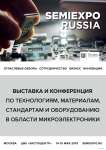Nanotechnologies in Construction: A Scientific Internet-Journal @nanobuild-en
Статьи журнала - Nanotechnologies in Construction: A Scientific Internet-Journal
Все статьи: 572
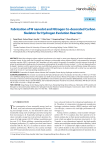
Fabrication of W nanodot and Nitrogen Co-decorated Carbon Skeleton for Hydrogen Evolution Reaction
Статья научная
Metal dots-nitrogen-carbon catalysts have become a hot topic in recent years because of special coordination environment. Herein, for the study the W nanodots and nitrogen co-decorated carbon skeleton (W@NC) was prepared for hydrogen evolution reaction (HER). In particular, NaCl templates not only restrict the growth of nanodots, but also improve the purity of phase. By optimizing the feeding ratio of ammonium metatungstate, W nanodots (the size is about 1.2 ± 0.6 nm) dispersed well on N-doped C skeleton, and this special structure could effectively promote electron transfer and ion diffusion during HER process. As a result, the optimized W@NC hybrids exhibited excellent HER performance in alkaline media with a rather low over-potential (228 mV at 10 mA cm–2) and outstanding durability over 10 h.
Бесплатно
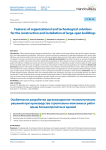
Статья научная
Introduction. Cable-stayed structures occupy a special place in the modern construction industry due to their unique characteristics and wide application possibilities. They allow to convey architectural expression of large span buildings and to ensure high efficiency and minimal weight of structures. Systems with cross arranged cables and arch cable-stayed combined solutions, including "tensegrity" structures, are of particular interest nowadays. Materials and methods. The study is based on an analysis of regulatory documents, scientific and technical literature reflecting the installation of cable-stayed structures, including requirements for the quality of materials, installation processes and structural reliability control. A comparative analysis of various types of cable-stayed systems (parallel, radial and cross arranged) is carried out, and examples of their practical application are considered. Results and discussion. Based on the analysis of regulatory documents and scientific and technical literature review, cable-stayed structures were classified into various categories, reflecting their design features and applications. The advantages and disadvantages of each type of cable-stayed coverings were analyze as well as progressive methods of installations were revealed. Conclusion. The use of cable-stayed coverings, especially with cross-arranged cables and "tensegrity" structures are a promising direction in modern construction. These structures allow to create complex architectural solutions, creating lightweight, aesthetically attractive coverings. At the same time, the design and installation of cable-stayed structures require consideration of all their disadvantages and limitations to ensure the strength and durability of buildings and structures.
Бесплатно

Fillers for polymer composite materials
Статья научная
Introduction. For the production of building products made of PVC, compositions are used that, along with the polymer, include additives: plasticizers, stabilizers, modifiers. This leads to a decrease in the chlorine content in the composition and increases the flammability of the productitself. Therefore, nanoparticles of various fillers are added into the compositions. Fillers inPVC compositions (more often inorganic, less often organic substances) are solid additives that differ from the polymer matrix in chemical composition and structure.In most cases, the main function of fillers is to reduce flammability and cut costs of the products obtained, in some cases they serve to impart or improve the following properties: reducing plasticizer absorption, changing in dielectric properties, increasing rigidity and hardness, reducing noise transmission, reducing toxicity of combustion products. Main part. Fillers are classified according to various criteria. According to the state of aggregation, they are divided into gaseous, liquid and solid. By their nature, they are divided into organic and inorganic; according to the source of receipt – reinforcing, strengthening, reinforcing, neutral; bythe size, particle shape and structure – into 4 main types: dispersed (powder); fibrous (fibers, threads, bundles, etc.); sheet (film) with a given structure (fabrics, paper, tapes, sheets, films, nets); volumetric (framework) with a continuous three-dimensional structure (bulk fabrics, felt, skeletal and porous frameworks). The most commonly used solid fillers, which are also called dispersed. The introduction of dispersed fillers into polymer composite materials (PCM) is more appropriate for creating mass-produced materials, more technologically advanced, with a low level of strength characteristics. Dispersed fillers are introduced into thermoplastics with high fracture energy to reduce their cost, increase stiffness and compressive strength, and improve their technological characteristics during processing. At the same time, their tensile strength and impact strength decrease due to reduction in the proportion of polymer in the filled composition. The introduction of solid and hard particles leads to an increase in the elastic modulus (E); and soft, elastic or gaseous fillers – to its decrease. According to the mechanism of action, dispersed fillers can be divided into inert ones, which do not affect the properties of the matrix and are introduced into its composition to reduce the cost of the composition, and active ones. Dispersed fillers are divided into mineral, organic and metal. The commonest of those are minerals. Conclusion. Thus, at present, there are a large number of substances and materials used as fillers and making it possible to obtain PCM with low shrinkage and shape stability of products, high mechanical properties and the necessary set of special properties. Due to fillers, PCM can compete with other materials such as glass, ceramics and even metal in most areas of human activity.
Бесплатно
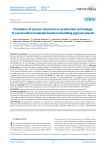
Статья научная
Introduction. This article presents the results of the research works on formation of building gypsum plaster porous structure with the use of recovered anhydrite raw materials and chemical additives, and describes a method for production of wall materials. The relevance of this paper is stipulated by the need to expand the range and increase the manufacture of heat-insulating and structural-heat-insulating products based on gypsum binders and local mineral raw materials, as well as the development of technologies to ensure the production of gypsum materials with improved performance. The authors proposed certain methods for forming the porous structure of building gypsum plaster and improving its performance in terms of porosity and thermal conductivity through the use of modified recovered raw materials and chemical additives of calcium chloride and sodium carbonate. Materials and methods. The study of the effect of modifying additives on the properties of the mixture was carried out using gypsum paste of normal consistency (NC = 55%). The preparation of samples and testing were performed according to the methods specified in the national standards with the use of porous additives of calcium carbonate, fluoroanhydrite and chemical additives for the rheological properties of the mixture, average density and strength of the samples, the patterns and mechanism of the processes of gypsum stone structure formation were established. Results. The application of fluoroanhydrite modified in the disintegrator with an equimolar amount of calcium carbonate leads to a decrease in the average density of the samples to 40% with evenly distributed pores. The analysis of the microstructure of heat-insulating material samples with a density of 550 kg/m3 showed that the average diameter of micropores is 0.45 mm, while the thermal conductivity of samples with complex chemical additives has the thermal conductivity coefficient of 0.25 W/m°C, which is 30% lower than the thermal conductivity of samples without complex additives. Conclusions. The results obtained create the basis for using recovery raw materials and domestic modifying additives as a pore-forming agent, which allow regulating the structure of gypsum stone in order to produce effective wall materials.
Бесплатно
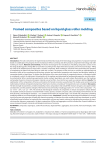
Framed composites based on liquid glass roller molding
Статья научная
Introduction. The work is devoted to the experimental and theoretical study of the technology and properties of composite materials based on soluble glass. The prospects for the manufacture of floor coverings and other products using frame technology and roller molding are shown. Materials and methods. The frame technology for the manufacture of building composites consists in the first stage of gluing grains of large filler to each other according to the shape of the future product, and in the second stage – filling the voids of the hardened porous frame with a solution component. Roller molding is used both when performing the operation of compacting the frame and when filling its voids with a matrix. The purpose of the work was to conduct an experimental and theoretical study of the manufacturing technology, physical and mechanical properties and chemical and biological stability of composites based on liquid glass. To analyze the mechanism of the stress-strain state of compacted mixtures, a rheological model is considered, in which the mechanical characteristics of the medium are determined by fundamental properties: viscosity, elasticity and plasticity. When conducting experimental studies, sodium liquid glass was used, sodium fluorosilicate was the hardener, and powders based on mineral and organic materials served as fillers. Furyl alcohol was used as a polymer additive. Results. The optimization of the compositions of frames and matrices for framed concretes was performed. The studies were carried out using mathematical methods of experiment planning. Three-factor matrices consisting of 10 experiments were considered. Discussion. The best strength characteristics are demonstrated by matrix compositions that include filler mixtures of quartz sand, pyrite cinders and diatomite, and the greatest strength of the framework is achieved by including granules of 5–10 mm in the composition – 7%, 2.5–5 mm – 23%, 1.25–2,5 – 70%. The chemical and biological resistance of composites on silicate and polymer silicate binders was studied. Chemical resistance was determined in water, aqueous solutions of caustic soda, technological environments of soft drink factories, and biological resistance – in a standard environment of mycelial fungi. It was found that composites containing modifying additives are characterized by higher resistance rates. Conclusion. Scientific and technological foundations for managing the structure and properties of liquid glass framed composites of vibration-free roller molding have been developed, as well as scientifically based solutions for improving the compositions of frame and matrix mixtures by regulating the processes of chemical interaction between components, the grain composition of fillers and aggregates, and the introduction of special additives to ensure increased strength, chemical and biological resistance of concrete.
Бесплатно
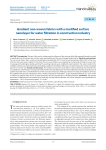
Статья научная
Introduction. The aim of the work is to determine the influence of the structure of the filter materials formed as a result of modification of the surface layer on their water permeability and the size of trapped solid particles. Materials and methods. The non-woven fabrics from a mixture of polyethylene-terephthalate (PET) (70 wt.%) and bicomponent fibers (BCF) of the coreshell structure were used as objects of the study. The non-woven fabrics were obtained by mechanically forming the canvas with its subsequent hardening by needle punching. The resulting materials were modified by heat treatment. The water transfer in the modified materials was determined by the permeability coefficient. The filtration efficiency was determined by the number of trapped particles of a certain size. Results and discussion. The needle-punched non-woven fabrics without additional heat treatment are not suitable for water filtration. The proposed method of thermal and deformation-thermal modification provides the production of gradient materials with a controlled thickness of the nanoscale surface layer. Although a decrease in water permeability is observed, the modified material traps solid particles with a smaller (compared to unmodified ~ 20 μm) equivalent diameter of 2–4 μm, which is sufficient to prepare water for use in steam generators and in the production of building materials. Conclusion. The optimal parameters of deformation-heat treatment for obtaining the high-effective filtration non-woven materials were established: the temperature – 180оC, the processing speed – 3.5 m/min.
Бесплатно

